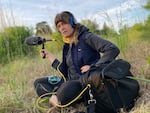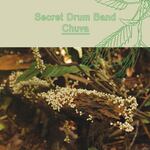“One of my favorite microphones to use that year was a very thin piece of metal with a contact mic that sound artist Chloe Alexandra made,” Lisa Schonberg said.
It’s common for musicians to geek out on the favorite pieces of gear they use to create their music. But when you ask Schonberg about her creative process, it tends to take an unexpected turn:
“It was super excellent at capturing the locomotion of ants: capturing the movement of an army ant raid, or leafcutter ants going along carrying leaves,” she said.
Schonberg isn’t a musician dabbling in science, or an entomologist with a weekend hobby band. Through her career she’s managed the unlikely pairing of the two, alternating between playing percussion on tour with her bands and doing fieldwork, investigating ecosystems that sustain insect life across the world. But in her most recent project, Secret Drum Band, she’s found a way to marry the two.

Secret Drum Band
Marcus Fisher
On its face, Secret Drum band is a percussion and electronic music group. With co-bandleader Allan Wilson (of the band !!!, or ‘chk chk chk’), Lisa sets up her instruments alongside an ensemble of other drummers. The current touring lineup includes drummers Anthony Brisson and Leah Bowden, as well as a number of what Schonberg calls “ambient musicians,” who manipulate synthesizers, guitars and other instruments.
The drummers build up dense, driving rhythms with patterns that interweave and ricochet off one another. A clattering crescendo often gives way to a sparse break, with the group’s ambient players weaving tones and field recordings through the songs. The effect is that of an abstracted natural environment: you often can’t pinpoint the exact vista evoked by the music, but you can feel its expanse and get fleeting glimpses as the music evolves.
Make it sound like a dinosaur
“The one thing that most of the songs have in common is that they start off with spending time in a place,” Schonberg said.
Schonberg’s songwriting process begins in the wild. She’ll find a natural space that speaks to her — often a place that has special significance due to an ecological issue or species she’s interested in — and sit there, listening.
“Sometimes the music composition process begins right there, on-site,” she said. She takes a field recorder to capture sounds and jots down musical notation that the space brings to mind. That can mean mimicking the rhythms she’s hearing, or patterns based on what she’s seeing: the way leaves bunch together on plants, or the feeling she gets from watching the erratic motion of a group of ants. “Sometimes I end up with more words on the paper than actual notes,” Schonberg said.
She then takes those notes and recordings and works with Wilson to write out drum parts for the rest of her ensemble. Sometimes the field recordings themselves end up in the final song, or she’ll give them to one of the group’s ambient players, along with what she calls a “dynamic map,” and then allows them to manipulate and interpret the sounds as they see fit.
“I’ll say, ‘Hey, in this section of the sound can you bring up that truck sound or that sound of the bird?‘” she said. “Sometimes I’ll say ‘Affect it, make it sound like a dinosaur here.‘”

Lisa Schonberg
Erica Valle
The balance of careful musical notation and the ensemble being free to improvise gives Secret Drum Band’s music its balance of order and freewheeling chaos — just like the environments that often serve as the music’s inspiration.
The Hylaeus bee project
After receiving a master’s degree in Environmental Studies from Evergreen State College, Schonberg spent several years bouncing between entomology field work and touring with her previous band, Explode Into Colors, before taking a job with the Xerces Society for Invertebrate Conservation in Portland.
She was tasked with studying Hawaii’s population of Hylaeus bees: a genus of tiny, shiny black insects that resemble wasps more than their familiar honey bee counterparts. They’re the only bees native to Hawaii, with 63 species identified as native to the islands: that’s more species of Hylaeus bees than are found across the entire continental United States. But the bees’ habitat was becoming increasingly rare.
Her job was to research the bees and suggest the best candidates for the federal endangered species list.

Lisa Schonberg makes a field recording at Ainsworth bluffs in Portland, Ore.
Anthony Brisson
“I had studied the Hylaeus at Xerces for only about six months and by no means was an expert of any sort, but I realized that I was one of the few people who had paid any prolonged amount of attention to them recently,” Schonberg said in her book “The Hylaeus,” documenting her research.
It took about nine years, but the petitions Schonberg co-authored led to seven species receiving protections under the Federal Endangered Species Act in 2016. They were the first bees to gain such protections in the country.
While she was in Hawaii, though, Schonberg saw an opportunity to combine her composition work with her desire to contribute to environmental education and activism. “It was right there,” she said.
Schonberg found that the bees were so endangered that they lived in a very limited number of sites on the island. In some places they were known for nesting in a single bush. She found her inspiration in Kaena Point, a remote protected area at the western tip of Oahu.
Field Recording from Kaena Point on Oahu, Hawaii.
She sat down with her field recorder and a notebook and jotted down how the patches of native plants sprawled over the ground as the strong winds whipped by her. “It’s a very fierce feeling,” she said. “I’ve seen amazing albatross there swooping right by your head. You feel like you have to be on your toes there.”
She took her notes and field recordings home to Portland with her and worked with Wilson to channel that power into music. The result is the song “Ka’ena Point” on Secret Drum Band’s new record Chuva:
Music Video for “Ka’ena Point” by CPJMLT
Amplifying the tropical ants
If there's one thing Schonberg wants you to know, it's that ants can talk.
"Most of the literature in the ant world is about chemical communication in ants," She said. "There hasn't been as much attention to acoustic communication in ants."
Ants actually produce stridulations by rubbing together certain body parts, like a cricket. A lot of these sounds are in the ultrasonic range, inaudible to the human ear. Schonberg has learned to capture these sounds using special microphones.
Stridulation from a species of Ectatomma ant. This was recorded while “interviewing” a single ant by holding it in forceps in front of an ultrasonic microphone.
She has also learned to capture the sound of ant locomotion, with contact microphones as they move over a surface. “And sometimes they just bite stuff and attack stuff.” She said that if scientists set a leaf next to an ants’ nest in lab conditions, “They’ll get really excited and send out recruitment signals — which is basically ants saying, ‘Hey, there’s food here, it’s really good!’”
Schonberg honed the ant recording techniques through her work with Labverde, a program that brings artists and scientists to the Amazon rainforest to document the changing ecology of one of the planet’s most important natural habitats. In 2017, she first went to Manaus, Brazil, with myrmecologist Fabricio Baccaro to study and record ants there. After three years of fieldwork, the project has grown with the help of additional collaborators into ATTA: Amplifying The Tropical Ants.
The song “Multispecies (Ants)” is just one of the fruits of that project:
Music video for “Multispecies (Ants)” by Blaire Stapp.
The song uses sounds from the first year of collection; that’s when the contact microphone designed by Chloe Alexandra came into play.
"Originally that song was just ant sounds," Schonberg said. "I affected them using a synthesizer, but tried to keep their original character because I wanted people to hear what ants actually sounded like." She created loops of the stridulations, locomotion and other ant sounds to create discernible rhythms. From that original sound piece, she wrote percussion parts echoing her original field recordings to create the final version.
"It's funny because people in Brazil say this sounds like Brazilian rhythms," she said, "but I didn't have any of that consciously in me!"
Reconsidering the insect
Through this music, Schonberg is hoping to encourage eco-centric thought: a recognition that every species has an intrinsic value that helps to hold our fragile world together.
"Ants are what ecologists call a keystone species," she said. "Without the ants, the ecosystem's functions would not go on."
These tiny insects actually perform an extraordinary range of essential functions throughout the Amazon rainforest: they’re herbivores, eating and thinning overgrown vegetation. They’re predators, consuming other insects. They work as seed dispersers and soil aerators.
“Without the ants, it’s hard to imagine what the tropical rainforest would look like,” Schonberg said.
She said this is especially crucial when we consider the Amazon’s central role in the global climate. The increasing pace of rainforest deforestation has a direct correlation to changes in global weather patterns. Scientists are increasingly worried that the Amazon could flip, turning to a dry habitat that is unable to restore itself.
"The ants are keeping that forest together," she said. "They're keeping it intact."
Through her work with ATTA and Secret Drum Band, Schonberg is hoping to get people to think more deeply about ants, opening our fascination up to the crucial role they play.
“I’m doing this work as an ask to the world to have more respect for insects,” she said. “To reconsider their perspective of insects; let’s reconsider our role in the world, who’s at the center.”
Secret Drum Band’s new record, “Chuva,” is out now on Moon Glyph records.

"Chuva," the new record by Secret Drum Band
Moon Glyph Records
Correction: This story has been updated to reflect the correct spelling of Allan Wilson’s name. OPB regrets the error.
